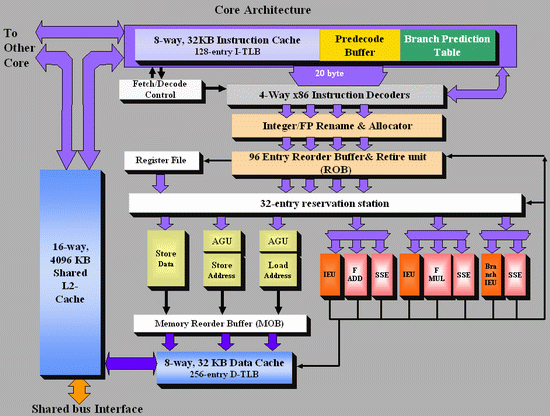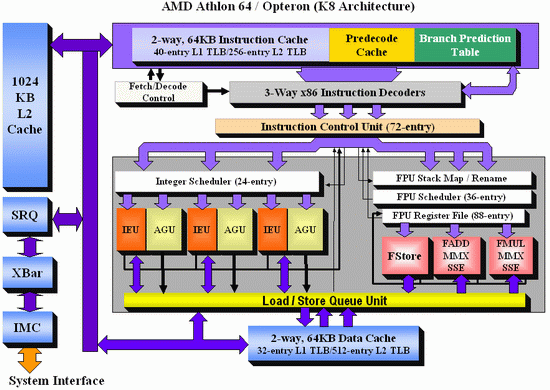Out of Order execution: AMD versus Intel
To make this article more accessible and to make the differences between the AMD K8 and the new Intel Core architecture more clear, I tried to make both CPU diagrams in the same style. Here's the Core architecture overview:
And here's the K8 architecture:

There are a few obvious differences: Core has bigger OoO buffers: the 96 entry ROB buffer is - also thanks to Macro-op fusion - quite a bit bigger than the 72 Entry Macro-op buffer of K8. The P6 architecture could order only 40 instructions, this was doubled to 80 in the P-M architecture (Banias, Dothan, Yonah), and now it's increased even further to 96 for the Core architecture. We've created a table which compares the most important architectural details of several current CPU families:
 |
| Click to enlarge |
The Core architecture uses a central reservation station, while the Athlon uses distributed schedulers. The advantage of a central reservation station is that utilization is better, however distributed schedulers allow more entries. NetBurst also uses distributed schedulers.
Using a central reservation station is another clear example of how Core is in fact the "P8", the second big improvement of the P6 architecture. Just like the P6 architecture, it uses a Reservation Station (RS) and allocates a specific execution unit to execute the micro-op. After execution, the micro-op results are stored in the ROB entry for that micro-op. This aspect of the Core design is clearly taken from the Yonah, Dothan and P6 architectures.
The biggest differences are not immediately visible on the diagrams above. Previous Intel architectures can only perform one branch prediction every two cycles, but Core can sustain one branch per cycle. The Athlon 64 can also perform one branch prediction per cycle.
Another impressive area is Core's SSE multimedia power. Three very powerful 128-bit SSE/SSE2/SSE3 units are available, and two of them are symmetric. Core will outperform the Athlon 64 vastly when it comes to 128-bit SSE2/3 processing.
On K8, 128-bit SSE instructions are decoded into two separate 64-bit instructions. Each Athlon 64 SSE unit can only do one 64-bit instruction at a time, so the Core architecture has essentially at least 2 times the processing power here. With 64-bit FP, Core can do 4 Double Precision FP calculations per cycle, while the Athlon 64 can do 3.
When it comes to integer execution resources, the Core architecture is an improvement over the Pentium 4 and Dothan CPUs, and is at the same level (if we only look at the number of execution units) as the Athlon 64. The Athlon 64 seems to have a small advantage when it comes to calculating addresses: it has 3 AGU compared to Core's 2. This could give the Athlon 64 an advantage in some less common integer workloads such as decrypting algorithms. The deeper, more flexible (Memory disambiguation, see further) out of order buffers and bigger, faster L2-cache of the Core should negate this small advantage in most integer workloads.










87 Comments
View All Comments
BigT383 - Monday, May 1, 2006 - link
I loved this article. It's due to articles like these that I've been reading Anandtech since before the days of the K6-2.PandaBear - Monday, May 1, 2006 - link
Of course Core should be better than K8, it better be.The only thing I am concerned about the Core architecture is with all these additional stuff, it will probably cost a lot to make, not just the CPU, but the MB, chipset, will also be expensive with the additional high speed circuitry. That means it will probably cost more.
K8 has been 5 years old and it is not bad standing against the latest and greatest. If AMD have something in the pipeline that will be the next monster CPU, it will be great. What I am concern about AMD is whether they can keep their yield up and have enough $ left behind to design K9 and beyond. Don't just sit there and lose the momentum they gain.
saratoga - Monday, May 1, 2006 - link
Core is a pretty conservative design with a pretty small die for a new core. It should be very economical to produce. Probably more so then the chips its replaceing.IntelUser2000 - Monday, May 1, 2006 - link
Not really. Not many expected that Intel will do more than increasing clock speeds and cache sizes since that's what they have been doing that since Pentium II.
http://www.reghardware.co.uk/2006/04/05/intel_conr...">http://www.reghardware.co.uk/2006/04/05/intel_conr...
The ASP went down. $530 for the fastest mainstream Conroe is rather good.
zsdersw - Monday, May 1, 2006 - link
The pricing put out by Intel suggests that Core will be priced very aggressively. I can't see the 975 chipset costing significantly more than it does now when Core is released.The fact that Core is going to be built on Intel's 65nm process means that the "additional stuff" you refer to will cost less than it would if built on the 90nm process. And the die size probably grew a little, but not enough to offset the cost gains from the 65nm process.
xtremejack - Monday, May 1, 2006 - link
K8 is only 3 years old. Didn't AMD celebrate their 3rd anniversary of Opteron a few days ago.Griswold - Thursday, May 4, 2006 - link
Its been sold for 3 years, but clearly the design is "a few days" older than that.evident - Monday, May 1, 2006 - link
as a junior computer engineer at villanova university, i found this article to be really informative and an awesome read. it's really cool to see the differences between these CPU architectures and shows that they are actually teaching me something useful!PeteRoy - Monday, May 1, 2006 - link
How can you say Netburst wasn't a huge success?I think Netburst was a success when it was launched and it should have died sooner, but it was good for it time and now it will be replaced.
JarredWalton - Monday, May 1, 2006 - link
NetBurst started at 1.5 GHz basically and topped out at 3.8 GHz. Compared to previous architectures, that's pretty tame. P6 went from 150 MHz to 1.26 GHz (and beyond if you want to count P-M). Success monetarily vs. success as an overall design are two different things, and clearly NetBurst ran into trouble. Where are the 5 GHz+ Tejas chips? Waiting somewhere beyond the thermal even horizon.... :)